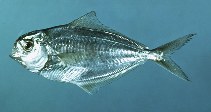Peprilus triacanthus (Peck, 1804)
Atlantic butterfish
Upload your photos and videos
Pictures | Google imagePeprilus triacanthus
Picture by Flescher, D.
Pictures | Google imagePeprilus triacanthus
Picture by Flescher, D.
Common names from other countries
Classification / Names ชื่อสามัญ | ชื่อพ้อง | Catalog of Fishes(สกุล, ชนิด) | ITIS | CoL | WoRMS | Cloffa
> Scombriformes (Mackerels) > Stromateidae (Butterfishes)
Etymology: Peprilus: Greek, peprilos, paprax, certain fish from Tracia.
Etymology: Peprilus: Greek, peprilos, paprax, certain fish from Tracia.
Environment: milieu / climate zone / depth range / distribution range นิเวศวิทยา
เกี่ยวกับทะเล,น้ำเค็ม; กร่อย กลุ่มสัตว์หน้าดิน,กลุ่มสัตว์พื้นท้องน้ำ; สัตว์น้ำที่อาศัยและอพยพภายในทะเลเท่านั้น (Ref. 51243); ระดับความลึก 15 - 420 m (Ref. 58426), usually ? - 55 m (Ref. 53006). Subtropical; 62°N - 26°N, 87°W - 52°W
การแพร่กระจาย ประเทศต่างๆ | พื้นที่จำแนกตาม FAO | ระบบนิเวศหลายระบบ | การปรากฏขึ้น,การเกิดขึ้น,พบ | Point map | การแนะนำ | Faunafri
Western Atlantic: from Labrador (Ref. 58426) to the gulf coasts of Florida (Ref. 2702). Absent in Bermuda or Caribbean (Ref. 26938).
Length at first maturity / ขนาด / น้ำหนัก / Age
Maturity: Lm 12.0 range ? - ? cm
Max length : 30.0 cm TL เพศผู้/กระเทย; (Ref. 7251); common length : 20.0 cm TL เพศผู้/กระเทย; (Ref. 2702)
Max length : 30.0 cm TL เพศผู้/กระเทย; (Ref. 7251); common length : 20.0 cm TL เพศผู้/กระเทย; (Ref. 2702)
Short description เครื่องมือที่ใช้ในการแยกชนิดสัตว์,สิ่งมีชีวิตออกจากกัน | สัณฐานวิทยา | ความยาวต่างๆ
เงี่ยงครีบหลัง (รวม) : 3; เงี่ยงครีบก้น: 3. This species is distinguished by the following characters: body oval to somewhat elongate, moderately deep (its depth 2.7 to 3 times in total length) and strongly compressed; eye medium-sized (its diameter 3.4 to 3.7 times in head length), surrounded by a small area of adipose tissue; snout short and blunt, lower jaw projecting somewhat beyond upper; mouth small, tip of maxillary not reaching to anterior eye margin; teeth in jaws very small, in a single row, while those in the upper jaw flattened and with 3 tiny cusps; dorsal and anal-fin bases very long (about equal in length), the anterior fin rays elevated, but fins not falcate, and both fins preceded by 3 short, weak, spines; caudal fin deeply forked; pectoral fins long (longer than head) and pointed; pelvic fins absent; a conspicuous series of 17 to 25 pores along anterior half of body under dorsal fin; lateral line high, following dorsal profile; scales small, present also on cheeks; caudal vertebrae 17 to 20; body color pale blue above, silvery below; numerous irregular dark spots on sides in live fish (fading after death) (Ref. 53006).
Forms large schools over the continental shelf, except during the winter months when it may descend to deeper water. Juveniles are generally found under floating weeds and jellyfish. Often found in brackish waters (Ref. 26938). Nerito-pelagic (Ref. 58426). Adults feeds mainly on jellyfish (Ref. 26938), squids, arrow worms, crustaceans and worms (Ref. 58426). Marketed fresh, smoked and frozen; eaten fried, broiled and baked (Ref. 9988). Mostly frozen and exported to Japan.
Life cycle and mating behavior วัยเจริญพันธุ์ | การสืบพันธุ์ | การวางไข่ | เซลสืบพันธ์ของเพศเมีย(ไข่) | ความดกของไข่ | ตัวอ่อน
Main reference
Upload your references | อ้างอิง | ผู้ประสานงาน | ผู้ร่วมมือ
Robins, C.R. and G.C. Ray, 1986. A field guide to Atlantic coast fishes of North America. Houghton Mifflin Company, Boston, U.S.A. 354 p. (Ref. 7251)
Threat to humans
Harmless
Human uses
การประมง: การค้า; การตกปลาเป็นกีฬา: ใช่
FAO(การประมง: การผลิต; publication : search) | FishSource | ทะเลรอบๆเรา
ข้อมูลเพิ่มเติม
Population dynamics
Growth parameters
Max. ages / sizes
Length-weight rel.
Length-length rel.
Length-frequencies
Mass conversion
การทดแทนที่
อุดมสมบรูณ์
Growth parameters
Max. ages / sizes
Length-weight rel.
Length-length rel.
Length-frequencies
Mass conversion
การทดแทนที่
อุดมสมบรูณ์
Life cycle
การสืบพันธุ์
วัยเจริญพันธุ์
ความดกของไข่
การวางไข่
Spawning aggregations
เซลสืบพันธ์ของเพศเมีย(ไข่)
Egg development
ตัวอ่อน
พลวัตของสัตว์น้ำวัยอ่อน
การสืบพันธุ์
วัยเจริญพันธุ์
ความดกของไข่
การวางไข่
Spawning aggregations
เซลสืบพันธ์ของเพศเมีย(ไข่)
Egg development
ตัวอ่อน
พลวัตของสัตว์น้ำวัยอ่อน
Distribution
ประเทศต่างๆ
พื้นที่จำแนกตาม FAO
ระบบนิเวศหลายระบบ
การปรากฏขึ้น,การเกิดขึ้น,พบ
การแนะนำ
BRUVS - Videos
ประเทศต่างๆ
พื้นที่จำแนกตาม FAO
ระบบนิเวศหลายระบบ
การปรากฏขึ้น,การเกิดขึ้น,พบ
การแนะนำ
BRUVS - Videos
Physiology
Body composition
Nutrients
การใช้ออกซิเจน
รูปแบบการว่ายน้ำ
ระดับความเร็วในการว่ายน้ำ
Visual pigments
Fish sound
Diseases & Parasites
Toxicity (LC50s)
Body composition
Nutrients
การใช้ออกซิเจน
รูปแบบการว่ายน้ำ
ระดับความเร็วในการว่ายน้ำ
Visual pigments
Fish sound
Diseases & Parasites
Toxicity (LC50s)
Human related
Aquaculture systems
ประวัติการเพาะเลี้ยงสัตว์น้ำ
สายพันธุ์
Ciguatera cases
Stamps, coins, misc.
Aquaculture systems
ประวัติการเพาะเลี้ยงสัตว์น้ำ
สายพันธุ์
Ciguatera cases
Stamps, coins, misc.
เครื่องมือ
E-book | คู่มือภาคสนาม | เครื่องมือที่ใช้ในการแยกชนิดสัตว์,สิ่งมีชีวิตออกจากกัน | ผู้มีความชำนาญในเรื่องความถี่ของความยาว | เครื่องมือในการศึกษาชีวประวัติ | ตำแหน่งบนแผนที่ | Classification Tree
| Catch-MSY |
Special reports
Download XML
แหล่งที่มาจากอินเตอร์เน็ต
Aquatic Commons | BHL | Cloffa | Websites from users | Check FishWatcher | CISTI | Catalog of Fishes(สกุล, ชนิด) | DiscoverLife | ECOTOX | Faunafri | Fishtrace | GenBank(genome, nucleotide) | GloBI | GOBASE | | Google Books | Google Scholar | Google | IGFA World Record | MitoFish | Otolith Atlas of Taiwan Fishes | PubMed | Reef Life Survey | Scirus | SeaLifeBase | แผนภูมิชีวิตแบบต้นไม้ | Wikipedia(Go, ค้นหา) | World Records Freshwater Fishing | บันทึกทางด้านสัตววิทยา
Estimates based on models
Preferred temperature (Ref. 115969): 5.1 - 24.7, mean 21.7 (based on 250 cells).
Phylogenetic diversity index (Ref. 82804): PD50 = 0.5020 [Uniqueness, from 0.5 = low to 2.0 = high].
Bayesian length-weight: a=0.01230 (0.00867 - 0.01745), b=3.14 (3.04 - 3.24), in cm Total Length, based on LWR estimates for this species (Ref. 93245).
ระดับชั้นอาหาร (Ref. 69278): 3.9 ±0.0 se; based on diet studies.
ความสามารถในการกลับคืนสู่ปกติ (Ref. 120179): ความสูง, เวลาต่ำสุดที่จะทำให้ประชากรเพิ่มขึ้นเป็น 2 เท่าใช้เวลาน้อยกว่า 15 เดือน (K=0.8(?); tm=1).
Fishing Vulnerability (Ref. 59153): Low vulnerability (20 of 100).
Climate Vulnerability (Ref. 125649): Low vulnerability (22 of 100).




